37 Filipino Foods to Try in 2025
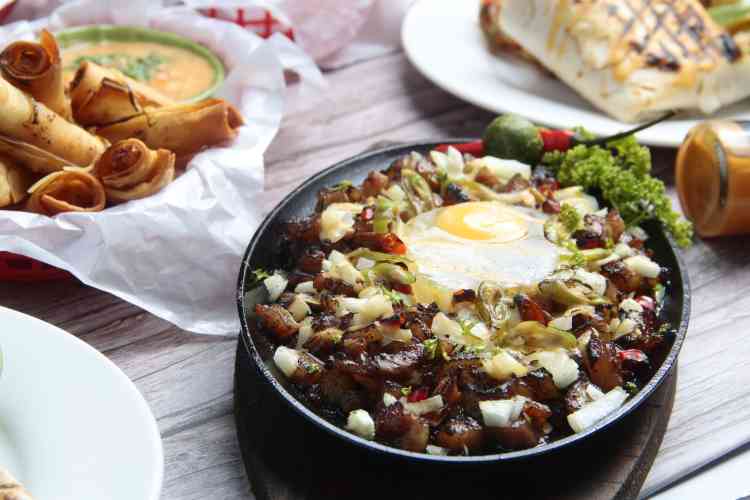
If you’ve never tried Filipino food, you’re missing out on an array of delicious meals that are as unique as their place of origin, representing a beautiful mosaic of cultures and flavors. On the western edge of the Pacific Ocean, you’ll find the Philippines, a tropical geographical area with over 7,000 individual islands.
In the Philippines, food is highly influenced by nearby Asian countries, such as Japan, China, Thailand and Vietnam. Even so, what makes Filipino food stand out is its ingenuity, according to the Philippine Information Agency. Salty, sweet and sour notes predominate in Filipino cuisine. However, many people find the spices and flavors of Filipino food to be similar to those of Spanish or Indonesian food.
One thing’s for certain: Filipino food is a completely unique combination of flavors and one of the best cuisines to try if you want to expand your palate and excite your taste buds. In this article, we’ll explore some of the best Filipino foods to try at home, on vacation or in a cooking class. As they say in Tagalog, “Kain tayo!” — Let’s eat!
Jump to Section
- How We Selected These Popular Filipino Dishes
- What Is Filipino Food?
- Filipino Breads
- Filipino Appetizers and Finger Foods
- Filipino Soups and Stews
- Filipino Dishes
- Filipino Desserts
- Filipino Drinks
- Common Filipino Spices
How We Selected These Popular Filipino Dishes
To create a list of traditional Filipino foods that is as authentic and all-encompassing as possible, our editorial team conducted extensive research to highlight the regional diversity and rich culinary heritage found across the archipelago.
Additionally, we also included information provided to us by the culinary experts on our team, drawing from their knowledge of organizing cooking classes, food tours and other chef-led experiences across the globe. These valuable insights shed light not only on the detailed make-ups of traditional Filipino foods, but also on why they matter and how they are prepared and enjoyed in everyday life.
Finally, each dish featured in this guide was selected based on the following criteria:
- Popularity and Recognition: The dishes included here are beloved staples across the country or are gaining recognition internationally.
- Culinary Variety: To reflect the depth of Filipino cuisine, this list spans appetizers, breads and soups, as well as main dishes, desserts and drinks.
- Regional Representation: We included dishes from Visayas, Luzon, Mindanao and other distinct regions to showcase the wide range of cooking styles, ingredients and flavor profiles unique to each area.
- Cultural Significance: This list includes foods that hold deep connections to Filipino traditions and significant occasions, such as religious celebrations, family gatherings and festive holidays.
- Authenticity and Tradition: We ensured that the dishes we included reflected traditional recipes and methods of preparation, honoring the roots of each dish.
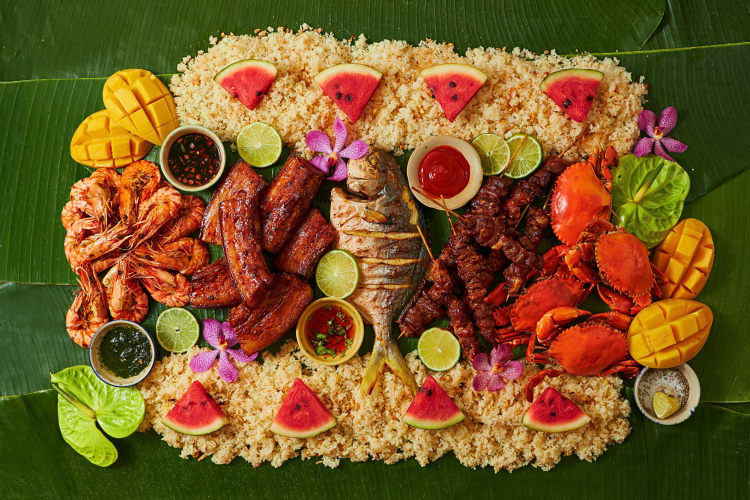
What Is Filipino Food?
If you’ve ever sat down to a delicious meal from the Philippines and wondered, “What is Filipino food?”, know that there’s a great deal of history rooted in every bite. Besides the culinary influences from beyond the country’s borders, Filipino food can be dissected and traced back to the lineage of more than 100 ethnolinguistic groups within the Philippines.
Today, there is a large variety of dishes that span the enticing Filipino foods list, many of which you’ll love as much as we do. Favorites include kare-kare, lechón and pochero. Food combinations are also an important part of the Filipino food culture, especially as a means to achieve sweet and salty flavors in a single meal. One such example is the pairing of tuyo (salty fish) with champorado (sweet porridge).
Food pairings are enhanced by the addition of sauces, which also play a crucial role in the preparation and consumption of Filipino food. According to DUNE: DigitalUNE, condiments used most often for food preparation are soy and fish sauces, and vinegar. When it comes to ingredient staples, you’ll usually find that meals feature rice, noodles, calamansi (a citrus fruit) and pork.
If this cuisine sounds intriguing, one of the best ways to learn about Filipino foods is to make them for yourself. Whether you're looking for cooking classes in the Bay Area, cooking classes in NYC or other culinary classes near you, you can take a hands-on approach to Filipino cuisine that will help you appreciate all the flavors, textures and aromas behind these complex cultural dishes.
Can’t attend in-person classes? No problem! For a virtual experience with Filipino food, explore online cooking classes that can be taken from anywhere in the world.
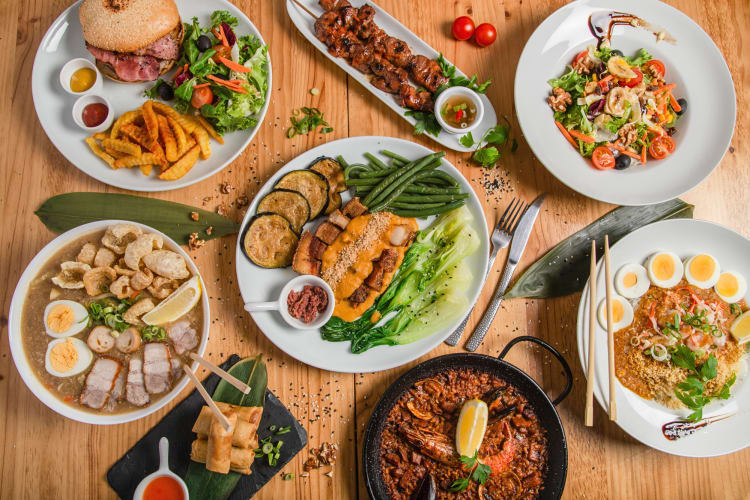
Filipino Breads
1. Pandesal
In Spanish, pandesal literally translates to “bread with salt.” This simple and classic roll is made with very few ingredients, typically wheat flour, water and eggs, combined with yeast and salt. Sometimes, sugar is added to the dough to give the rolls a slightly sweet flavor that pairs well with several Filipino foods.
Pandesal is one of the most quintessential Filipino foods, often served as a snack, appetizer or quick breakfast dipped in coffee. For many people, pandesal has a sentimental value as well, reminding them of time spent with family and preparing meals.
- Pairs Well With: Hot coffee, kesong puti.
- Spice Level: None
- Dietary Notes: Vegetarian
- Cooking Notes: Best when freshly prepared. Toast slightly before serving.
- Where To Buy: Filipino or Asian bakeries, and online Filipino grocery stores.
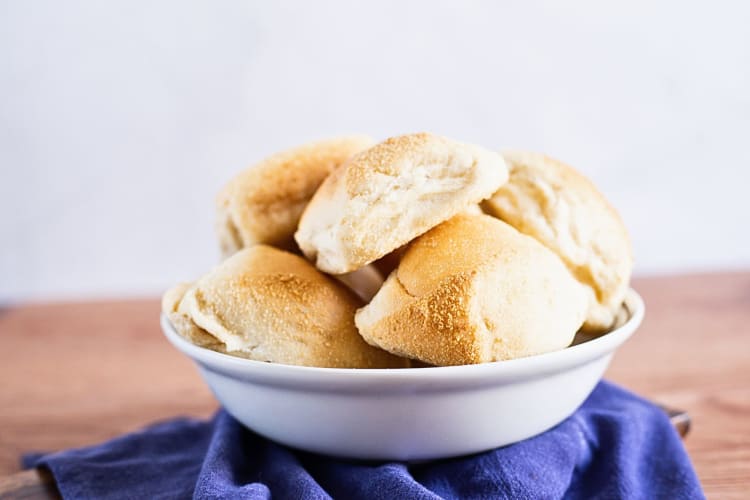
2. Pan de Coco
On the outside, this Filipino food may look similar to pandesal, but bite into this tender bread roll and you’ll be delighted to find a filling made with sweet shredded coconut and brown sugar. Pan de coco is a popular snack or breakfast roll in the Philippines and pairs wonderfully with hot coffee or tea.
Pan de coco actually originated in Honduras, but Hondurans typically mix the sweetened coconut into the bread dough, while Filipinos prefer to stuff the bun with the coconut filling. As a staple Filipino food, you can easily find pan de coco in bakeries and cafés, or you could even bake a fresh batch yourself at home.
- Pairs Well With: Sweet coffee, fruit jam, tea.
- Spice Level: None
- Dietary Notes: Vegetarian
- Cooking Notes: Be careful not to overbake to avoid the filling from drying out.
- Where To Buy: Filipino bakeries and specialty Asian stores.
3. Kababayan
Kababayan, also called kabayan, is a sweetened bread roll with a texture that is very similar to a cornbread muffin. This popular Filipino food is made with flour, eggs and brown sugar, together with evaporated milk and vanilla extract.
Baked in a muffin tin, kababayan is intended to look like the straw hats of the native Pinoy people, called salakots. Like pandesal and pan de coco, kababayan is a Filipino food that’s a bakery favorite and traditionally enjoyed with coffee or tea.
- Pairs Well With: Breakfast spreads, tea.
- Spice Level: None
- Dietary Notes: Vegetarian
- Cooking Notes: Bake in muffin tins for a traditional shape.
- Where To Buy: Filipino bakeries.

4. Kalihim
Kalihim is a traditional Filipino food that’s sure to catch your eye in any bakery. Also called pan de pula, pan de regla or ligaya, kalihim is a soft bread bun with a sweet, bright red filling.
This Filipino food’s filling is actually made from day-old bread that gets repurposed into pudding with milk, eggs and butter, combined with sugar and red food coloring. The pudding is then wrapped with fresh dough, baked and sliced to create a new tasty treat. The name “kalihim” roughly translates to “secret” because bakers were able to “secretly” reuse their unsold bread to make this Filipino food!
- Pairs Well With: Coffee, milk tea.
- Spice Level: None
- Dietary Notes: Vegetarian
- Cooking Notes: To avoid soggy bread, let the filling cool completely before wrapping it in dough.
- Where To Buy: Filipino bakeries.
Filipino Appetizers and Finger Foods
5. Chicharon
Chicharon is a popular dish across many Spanish-influenced cultures. Also known as pork cracklings or pork rinds, chicharon in Filipino cuisine is a savory snack or appetizer most often made with crispy fried pork belly. However, you'll also find this Filipino food being made with chicken or beef.
In the Philippines, chicharon is frequently enjoyed as a bar food to balance out a night of drinking with friends. When it isn’t being served to rowdy crowds, it can also be used as a garnish to other Filipino foods such as soups and stews.
- Pairs Well With: Beer, vinegar dip.
- Spice Level: Mild to moderate.
- Dietary Notes: Gluten-free
- Cooking Notes: Fry twice for extra crunchiness.
- Where To Buy: Filipino stores, supermarkets, online.
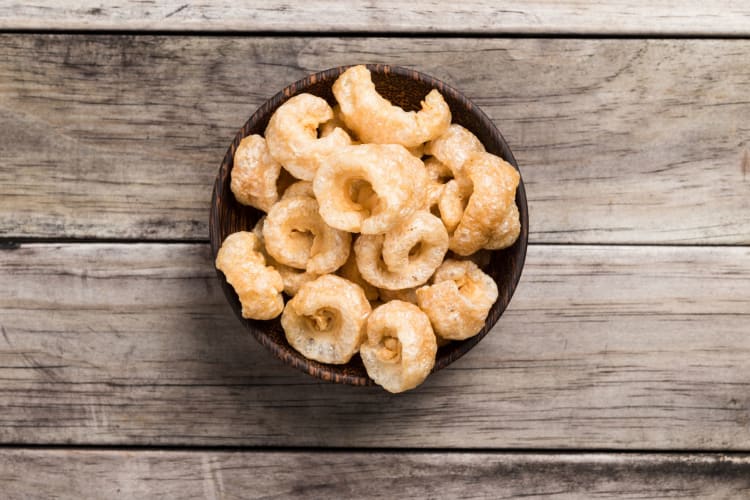
6. Lumpia
Lumpia, also known as lumpiang Shanghai, is very similar to Vietnamese egg rolls and spring rolls found in local Asian cuisines. The Filipino version is made with savory ingredients like pork, cabbage, onions, carrots and other vegetables. The chosen ingredients are wrapped in a thin pastry and deep-fried to create a hot and crispy Filipino food that's regularly enjoyed as a snack.
Lumpia is often served as an appetizer or finger food at family gatherings and celebrations, but can be enjoyed anytime as a snack or side dish to a larger meal. While it's most often served hot and fried with a dipping sauce, some people also enjoy fresh versions of this Filipino food, known as lumpiang sariwa.
- Pairs Well With: Rice dishes, sweet chile sauce.
- Spice Level: Mild
- Dietary Notes: Vegetarian if no meat is used.
- Cooking Notes: Seal the wrapper with egg wash to avoid any leaks.
- Where To Buy: Filipino grocery stores and restaurants.
7. Okoy
Okoy, also called ukoy, is a savory Filipino food made with deep-fried rice batter, shrimp and vegetables. The most common vegetables used to make this dish are carrots, onions and sweet potatoes, as well as cassava, mung beans and scallions. The ingredients are scooped into a rough patty shape, then lowered into the deep-fry oil until they are perfectly hot, juicy and crispy.
Okoy is frequently enjoyed as an appetizer or snack and is one of the most common street foods in the Philippines. When dipped in a tasty garlic and vinegar sauce, this is one Filipino food you’ll crave again and again, just as we do.
- Pairs Well With: Sinangag, green mango with bagoong.
- Spice Level: Mild to medium
- Dietary Notes: Pescatarian; vegetarian if no shrimp is used.
- Cooking Notes: Fry in small batches to keep crispy.
- Where To Buy: Wet markets, food stalls.

8. Sisig
Sisig is a minced meat dish usually enjoyed as bar food or an appetizer, but it can also be served as an entrée alongside rice or other Filipino foods. Traditional sisig is most commonly made from pork and chicken liver, but today, there are plenty of variations in ingredients. Other variations are made with mussels, tuna and squid, as well as eggs, ox brain, ostrich and even crocodile. For vegetarians, tofu sisig is even an option.
This Filipino food was invented by a restaurant owner from the Pampanga province who noticed that a nearby U.S. military base was wasting meat from pigs’ heads. The delicious and inventive dish is made by boiling the pig’s head to remove the flesh, then chopping and grilling the meat with fragrant spices, onions, calamansi juice and chicken liver, before serving it on a sizzling cast-iron plate.
- Pairs Well With: Garlic rice, beer.
- Spice Level: Medium to high.
- Dietary Notes: Can be vegetarian or gluten-free, depending on ingredients.
- Cooking Notes: Top with a cracked egg on the sizzling plate for added richness and texture.
- Where To Buy: Filipino restaurants, Pampanga eateries.
9. Balut
Perhaps not for the faint of heart, balut is a hands-on culinary experience like few others around the world. This Filipino food consists of a fertilized duck egg with a two-to-three-week-old duck fetus contained inside. Balut is prepared by boiling or steaming the whole egg, euthanizing the fetus and cooking the egg contents, creating a texture similar to that of a soft-boiled egg.
To eat balut, crack and peel open the top of the eggshell and sip out the liquid. Then add your preferred seasonings and eat the contents straight from the shell. Many people say this unique Filipino food tastes like chicken noodle soup!
- Pairs Well With: Beer, vinegar, salt.
- Spice Level: None
- Dietary Notes: Gluten-free
- Cooking Notes: Steam gently for 20 to 30 minutes to heat through without overcooking the yolk.
- Where To Buy: Street vendors, local markets.
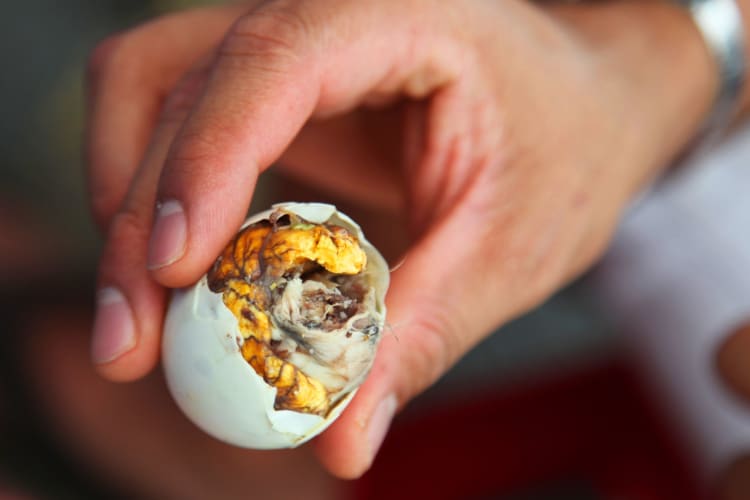
10. Tokwa't Baboy
Tokwa't baboy is a savory Filipino food made with deep-fried tofu, boiled pork belly and boiled pork ears. The tofu and pork are simmered in or served alongside a sauce of vinegar, pork broth and soy sauce, as well as onions and red chile pepper.
Tokwa't baboy is usually served as a side dish or as pulutan, similar to Spanish tapas. However, some people may also enjoy having tokwa’t baboy as an entrée alongside other Filipino food staples, like rice or porridge.
- Pairs Well With: Beer, lugaw.
- Spice Level: Mild to medium.
- Dietary Notes: Gluten-free, depending on ingredients used.
- Cooking Notes: Drain and pat tofu dry before frying to ensure crisp edges.
- Where To Buy: Filipino eateries.
Filipino Soups and Stews
11. Sinigang
Much of the daily Filipino diet consists of soups and stews, and sinigang is a traditional favorite Filipino food, perfect for warming up on a chilly day. Sinigang is a category of sour stews that can be made with pork, fish, shrimp or beef, as well as a variety of vegetables like taro, green beans, tomatoes, onions and more.
The key ingredient in any sinigang recipe is a souring agent, usually sourced from fruits like tamarind, guava, santol or kamias. Depending on the main ingredients, this Filipino food may have different names, like sinigang na hipon or sinigang na baboy.
- Pairs Well With: Rice, tortang talong.
- Spice Level: Mild to medium.
- Dietary Notes: Gluten-free, depending on ingredients used. May find vegetarian and vegan versions.
- Cooking Notes: Add extra tamarind to adjust the sourness.
- Where To Buy: Filipino grocery stores, wet markets.
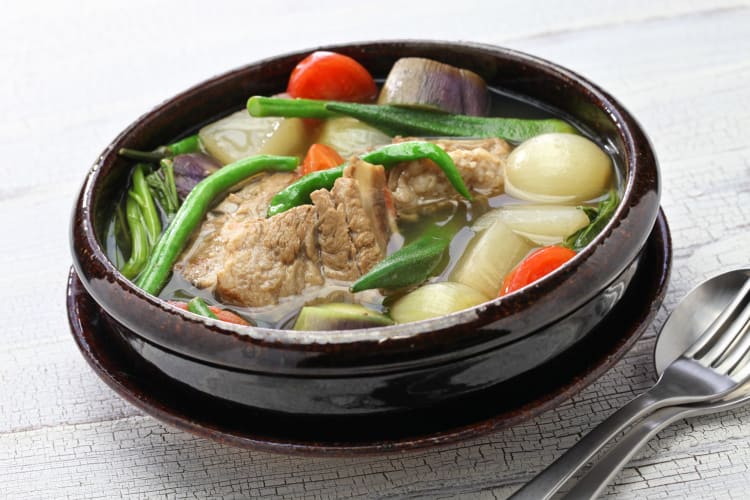
12. Nilagang Baka
Nilaga is another category of Filipino food very similar to sinigang, except that nilaga stew is made without a souring agent and may contain different vegetables. Nilagang baka is made with beef, usually beef shanks, along with peppercorn, fish sauce and vegetables like onions, cabbage, potatoes and green beans. Tendinous beef shanks are ideal for giving the slow-cooked broth a full-bodied, almost gelatinous appeal.
Nilagang baka is considered one of the best Filipino foods to eat when you’re feeling under the weather or keeping warm on a cold, rainy day. Sometimes, this wholesome stew is also enjoyed at family gatherings, as its soothing flavors bring everyone closer together.
- Pairs Well With: Patis, rice.
- Spice Level: None
- Dietary Notes: Gluten-free
- Cooking Notes: Best served when the meat is boiled until tender.
- Where To Buy: Filipino eateries.
13. Tinola
Tinola is a classic Filipino food with a fragrant and zingy flavor. Individual family recipes may vary, but it is usually made with chicken, fish sauce, and green papaya or chayote. Other ingredients added to it include onions, ginger and garlic, as well as moringa and chile pepper leaves for added flavor.
Like niligang baka, we think this Filipino food is an awesome dish to have when you need an immune boost. The broth itself is light enough to comfort upset stomachs, while the fragrant ginger, garlic and chile pepper leaves soothe congestion.
- Pairs Well With: Galunggong, ensaladang talong.
- Spice Level: Mild
- Dietary Notes: Usually gluten-free, vegetarian if no chicken is used.
- Cooking Notes: Sauté the ginger first to fully release its aroma, then add the remaining ingredients.
- Where To Buy: Restaurants, markets, Asian grocery stores.
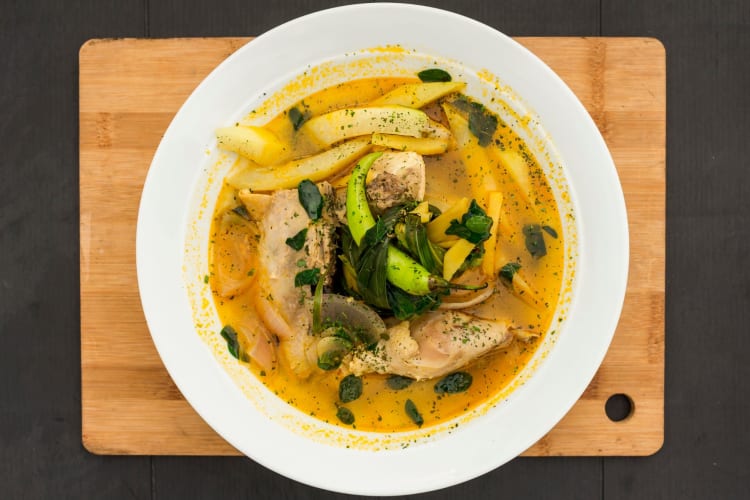
14. Kaldereta
“Kaldereta” is a term that can refer to almost any Filipino food cooked in a simmering tomato sauce. When referring to the specific dish, kaldereta is a tomato stew made with goat’s meat, also called kalderetang kambing. Other ingredients may include chicken, beef, pork or liver sauce, as well as potatoes, bell peppers, chile peppers and olives.
Kaldereta has a rich, savory flavor and hearty texture that is wonderful on its own or paired with other Filipino foods, such as steamed rice or a trusty pandesal roll. The name itself comes from the Spanish word “caldera,” like a cauldron of flavorful meat.
- Pairs Well With: Fried plantains, atchara, steamed rice, pandesal roll.
- Spice Level: Medium
- Dietary Notes: Usually gluten-free.
- Cooking Notes: Use liver spread for a richer sauce.
- Where To Buy: Carinderias, Filipino markets.
15. Dinuguan
Dinuguan is a traditional savory stew made with chunks of pork meat or pork offal, but it’s the broth base of this Filipino food that piques many people’s interest. The root word of dinuguan is “dugo,” which translates to “blood.” As the name might suggest, dinuguan stew is simmered with a broth of pig’s blood, vinegar, chile and garlic, giving it an intense and savory flavor with some classic sour notes.
This dark and hearty Filipino food goes by many other names throughout the Philippine islands, such as dinardaraan, sinugaok, tid tad or even jokingly, “chocolate stew.” To balance its bold flavor, dinuguan is often served as an entrée over white rice.
- Pairs Well With: Puto, tokwa't baboy.
- Spice Level: Medium to high.
- Dietary Notes: Can be made gluten-free.
- Cooking Notes: Add vinegar gradually to balance flavors.
- Where To Buy: Filipino wet markets.
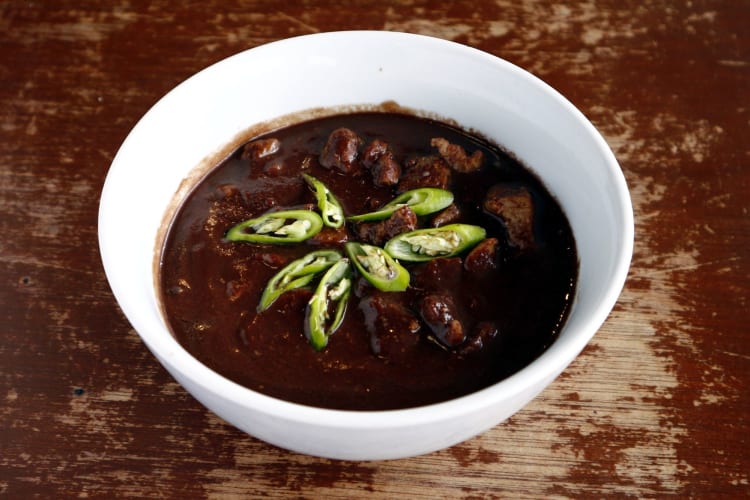
16. Kare-Kare
As you can tell by now, soups and stews are a significant part of Filipino cuisine. One of the most popular dishes to fall into this category is kare-kare. Looking at its name, you might think this peanut stew has ties to Indian curry, and you wouldn’t be wrong. This Filipino food has fewer spices and less heat, but many believe it was inspired by Indian cuisine.
So, does it share the same ingredients as a curry? Although variations of this Filipino food exist, its nutty broth includes staple ingredients such as onion, garlic and powdered annatto seed, mixed with toasted ground rice and peanuts.
Fatty meat (traditionally oxtail) is added to this mixture, together with vegetables such as long beans or baby bok choy. This delicious Filipino food is traditionally prepared in a clay pot called a “palayok.”
- Pairs Well With: Rice, bagoong.
- Spice Level: Mild
- Dietary Notes: Vegetarian if no meat is used.
- Cooking Notes: Soak the meat in water for several hours before cooking to avoid an earthy taste.
- Where To Buy: Festivals, Filipino grocery stores.
17. Bicol Express
Like kare-kare, this Filipino food features the delectable flavors of garlic and onion. However, the broth is creamier thanks to a coconut milk and shrimp paste base. Garlic and chile peppers are also added to the mixture, so if you’re a fan of fiery foods, this is definitely one to try. If you’re wondering where the protein comes from, small pieces of fatty pork tie this meal together for a hearty mix in every spoonful.
Of all Filipino meals, this one arguably has the strangest name. Why is that, exactly? It is believed that this dish was served to passengers on trains who were on their way to the Bicol region. Apparently, at the time, it didn’t have a name, but this Filipino food is now a well-known meal across the whole country.
- Pairs Well With: Ensaladang talong, steamed rice.
- Spice Level: High
- Dietary Notes: Vegetarian if no meat is used.
- Cooking Notes: Use siling labuyo for authentic heat.
- Where To Buy: Filipino stores and restaurants, especially those in Bicol.

Filipino Dishes
18. Adobo
It’s relatively uncommon to find Filipino dishes in other countries across the globe, but that’s not the case here. Adobo is one Filipino food that has taken the world by storm. This popular cooking style involves marinating meats (usually pork or chicken) or vegetables in a brine of salt, vinegar and soy sauce, along with pepper, garlic and other spices.
Pork adobo and chicken adobo are the most popular iterations of this Filipino food, which has a wonderfully tangy flavor. While adobo is admired today as an easy and delicious cooking method, it’s speculated that native people once used it as a way to preserve meat. Although it’s most commonly referred to as a cooking style, many also regard it as the country’s unofficial national dish.
- Pairs Well With: Boiled egg, rice.
- Spice Level: Mild
- Dietary Notes: Non-vegetarian
- Cooking Notes: For optimal flavor, marinate the meat overnight.
- Where To Buy: Restaurants, Filipino grocery stores.
19. Pancit
Pancit, or pansit, is another broad term for Filipino dishes made with a base of rice noodles. Some common varieties include bihon pancit with stir-fried meat and vegetables, pancit palabok with shrimp sauce and egg, and pancit habhab with stir-fried egg noodles.
Pancit dishes are largely influenced by Chinese culture, but they have found a welcome place at the dinner tables of many Filipino families. The different varieties of this delectable Filipino food are traditionally served to celebrate birthdays, likely because noodles symbolize a long life and good health in Chinese culture.
- Pairs Well With: Spring rolls, calamansi.
- Spice Level: None to mild.
- Dietary Notes: Vegetarian if no meat is used.
- Cooking Notes: When tossing the noodles, do so gently to avoid breaking them and to keep the dish visually appealing.
- Where To Buy: Fast food chains, wet markets.

20. Pinakbet
Pinakbet is a popular Filipino food from the northern Ilocos region. It is made with various on-hand vegetables, such as eggplant, green beans, okra and tomatoes. These vegetables are usually combined with pork belly in a fermented fish paste or shrimp paste.
Pinakbet is one of the simpler and healthier Filipino foods, making it a classic go-to at restaurants or in homes during family meals. The name translates to “shriveled,” referring to the way that the vegetables shrivel after cooking for a long time on low heat.
- Pairs Well With: Rice, fried fish.
- Spice Level: None
- Dietary Notes: Gluten-free. Can be made vegetarian or vegan if no meat or seafood ingredients are used.
- Cooking Notes: Simmer gently to preserve texture.
- Where To Buy: Ilocos markets.
21. Betamax
One of the more iconic and unique Filipino foods, betamax is made from chicken’s blood, which is cooled, coagulated and cut into square shapes. “Betamax” started out as a nickname for the food because the perfectly rectangular, dark cubes resemble an old Sony Betamax videotape.
After being formed and cut, the coagulated blood squares are placed on a skewer and grilled. Many people say that this unconventional Filipino food has little to no taste on its own, with a texture similar to liver. It is most often served as an affordable street food or afternoon snack (merienda) with chile vinegar dipping sauce.
- Pairs Well With: Grilled isaw, atchara.
- Spice Level: None
- Dietary Notes: Non-vegetarian
- Cooking Notes: Grill over charcoal for a smoky taste.
- Where To Buy: Markets, street vendors.

22. Torta
“Torta” can refer to a lot of foods across many Spanish-influenced cultures. In the Philippines, though, torta most often refers to an omelette-like Filipino food made with eggs and another ingredient, such as crab, eggplant or ground meats.
Filipino tortas are more like a fritter than a traditional breakfast omelette. How so? Well, when making it, the meat and vegetables are cooked separately, before they’re mixed in with the egg batter and poured into a skillet, similar to a pancake, to cook the eggs. Tortas are usually served as a breakfast Filipino food, paired with banana ketchup.
- Pairs Well With: Garlic-fried rice, ensaladang kamatis.
- Spice Level: None
- Dietary Notes: Vegetarian if no meat is used.
- Cooking Notes: Pre-cook the fillings to layer flavors.
- Where To Buy: Carinderias
23. Lechón
Lechón is one of the Philippines' most well-known foods, with a name that translates to “roasted piglet.” However, this dish isn’t usually made with piglets but rather with one fully-grown pig, lightly seasoned and roasted whole. This popular Filipino food is prepared in one of two ways: Manila or Luzon lechón, whereby the pig is seasoned with salt and pepper, and Visayas or Cebu lechón, which involves stuffing the pig with various spices.
Part of what makes lechón so world-famous, and we’d have to agree, is its striking visual appearance. The entire pig is spit-roasted after having been cleaned and stuffed, creating a large, golden-brown meat dish that retains its original piggy shape. Lechón is considered a delicacy, and it is most often served at big celebrations or as a popular Filipino Christmas food.
- Pairs Well With: Rice, sarsa.
- Spice Level: Mild
- Dietary Notes: Gluten-free
- Cooking Notes: Roast over wood fire for crispy skin.
- Where To Buy: Lechoneras, other eateries.

24. Pork Skewers
Skewers are one of the most popular Filipino street foods, with pork skewers being a huge crowd favorite. To make this delicious Filipino food, pork shoulder, butt, belly and sometimes other parts are marinated in savory barbecue spices, pierced with bamboo skewers and then grilled over wood charcoal.
Like hamburgers at American backyard barbecues, pork skewers are a go-to Filipino food at celebrations, special events, children’s birthdays and family gatherings. While pork is very popular, it’s also common to find other skewered treats, such as chicken feet and skin, betamax and organ meats.
- Pairs Well With: Garlic vinegar dip, grilled corn with butter or cheese.
- Spice Level: Medium
- Dietary Notes: Gluten-free
- Cooking Notes: Soak bamboo skewers before grilling.
- Where To Buy: Filipino stores, street stalls.
25. Silog
One might say this is the Philippines' version of an English or American breakfast, and we agree that it certainly rivals those meals in taste. With a simple combination of fried rice, fried eggs and a salty processed or cured meat, it’s an ideal meal to start off the day.
As is the case with other Filipino food traditions involving rice, a cold serving from the night before is typically used. The oil that’s used to fry the rice is first cooked and infused with garlic for added flavor. This meal takes on different names based on the combination of foods used; for example, a trio of rice, eggs and tapa is known as a “tapsilog.”
- Pairs Well With: Tomato and onion salad, hot pandesal with butter.
- Spice Level: None
- Dietary Notes: Gluten-free, depending on ingredients used.
- Cooking Notes: For added crispness and traditional presentation, give the fried egg slightly crispy edges.
- Where To Buy: Filipino diners.

26. Filipino Spaghetti
Like most people, you’re probably wondering, “What’s the difference between this Filipino food and Italian spaghetti?” The answer lies mainly in a single ingredient — bananas. As peculiar as that sounds, we suggest you don’t bash it until you’ve tried it, as many people swear by this being one of the best Filipino dishes.
This interesting meal was born out of necessity when Filipinos made red-dye ketchup from bananas. Why would they do that? Well, during World War II, there was a tomato ketchup scarcity, and locals were looking for something to add to spaghetti and chopped hot dogs — a recipe that was introduced to them by Americans.
Fast forward many years, and the sweeter and spicier banana-flavored ketchup is a staple in many Filipino households and fast food chains. When combined with spaghetti and hot dogs, the result is a syrupy, savory Filipino food that often gets topped with grated cheese.
- Pairs Well With: Pandesal, fried chicken.
- Spice Level: Mild
- Dietary Notes: Non-vegetarian
- Cooking Notes: Sauté the hot dogs before adding them to the sauce for a richer flavor and ideal texture.
- Where To Buy: Fast food chains.
27. Bibingka
Bibingka is one of the more common Filipino foods known across the world, and for good reason — it’s incredibly delicious. Simply put, it’s a rice cake with a caramelized top, achieved with a very specific cooking technique: low heat is applied on the bottom, contrasting with high heat on top.
If you’re searching for Filipino food ideas for holiday gatherings, this tasty snack makes for an ideal appetizer, as it’s synonymous with Christmas in the Philippines. That doesn’t mean it’s not eaten year-round, especially with the different kinds of bibingka on offer. Variations of this Filipino food include those with toppings such as red bean, cheese, salted egg yolk and sugar.
- Pairs Well With: Grated coconut, salted duck egg, hot tsokolate.
- Spice Level: None
- Dietary Notes: Vegetarian, gluten-free
- Cooking Notes: For a traditional touch, cook the bibingka in clay pots.
- Where To Buy: Bakeries, street vendors.

28. Tortang Talong
If you’re familiar with Spanish, you’ll know that the word “torta” refers to cake-like dishes or those that resemble a loaf. That’s also the case with this Filipino food, as in the Philippines, torta refers to an omelette-like dish made with any variety of ingredients.
Tortang Talong, specifically, is made with a whole eggplant. After being roasted until soft and smoky, the skin is removed, and the eggplant is mashed into a smooth purée. Finally, the new shape is dipped in beaten egg and fried, resulting in one of the best Filipino dishes for breakfast, lunch or as a snack. It’s usually served with rice and topped with fish sauce or banana ketchup.
- Pairs Well With: Atchara, Sliced tomatoes with salt and pepper.
- Spice Level: None
- Dietary Notes: Gluten-free. Vegetarian if no fish sauce is used, and vegan if no fish sauce or eggs are used.
- Cooking Notes: Allow the roasted eggplant to cool before peeling to preserve the flesh.
- Where To Buy: Local eateries.
Filipino Desserts
29. Ube Halaya
Ube halaya is a jam made from mashed purple yam, coconut milk, sweetened condensed milk and sometimes other flavorful ingredients. It is most often used to flavor other Filipino foods, such as bread and cakes, but it can also be enjoyed on its own as a creamy snack or dessert.
Aside from its scrumptiously sweet and nutty flavor, ube halaya has a gorgeous purple color that makes it incredibly eye-catching and Instagrammable. For this reason, this striking Filipino food has gained some traction on social media platforms in recent years. Ube powder and ube extract bring the delightful purple passion in this recipe for ube ice cream, a creamy, easy, no-churn treat.
- Pairs Well With: Cheese, pandesal.
- Spice Level: None
- Dietary Notes: Vegetarian, gluten-free.
- Cooking Notes: Use fresh ube to achieve the desired color.
- Where To Buy: Bakeries, Filipino grocery stores.

30. Ice Cream With Pandesal
Before the introduction of an ice plant in the Philippines in 1902, ice-based desserts were eaten mainly by the elites. When ice cream became more popular, it was referred to by street vendors as “dirty” due to its dirt-cheap selling price.
Before you get excited about common flavors such as strawberry, chocolate or vanilla, this Filipino food is rather unique. It comes in flavors such as ube, keso (cheddar cheese) and sweet corn.
Another element that sets it apart is that it’s often made with the milk of carabao, a local water buffalo. While ice cream is typically served in cones throughout the rest of the world, the Filipino version sometimes gets eaten sandwich-style on a pandesal.
- Pairs Well With: Tsokolate, turon.
- Spice Level: None
- Dietary Notes: Vegetarian
- Cooking Notes: Slightly toast the pandesal before filling to add crunch and prevent sogginess.
- Where To Buy: Ice cream vendors, street carts.
31. Halo-Halo
In Tagalog, halo-halo translates to “mix-mix” and is arguably the most popular sweet Filipino food, especially during the hot summer season.
This refreshing dessert can vary wildly depending on what you decide to add, but some essential components may include crushed or shaved ice, alongside leche flan or sweetened bean paste. Popular additions to this base include milk, jellies and jams, as well as shredded coconut, fresh fruit and other sweet Filipino foods.
Similar to a parfait, the ingredients of halo-halo are layered in a tall glass to form pretty layers and enjoyed with a spoon. As the ingredients melt, they can be mixed together for more fun flavor combinations. As preparing Asian desserts has been one of the top food trends on social media of late, don’t be surprised if colorful halo-halo graces your feed in the near future!
- Pairs Well With: Grilled banana cue, pandesal with cheese.
- Spice Level: None
- Dietary Notes: Vegetarian, gluten-free.
- Cooking Notes: Layer ingredients for the best look.
- Where To Buy: Dessert shops, halo-halo stands.

32. Champorado
If you’re someone who loves a dessert-type breakfast, this Filipino food is a must-try. Drawing inspiration from Mexican champurrado, this sticky rice porridge is traditionally served as a morning meal.
A combination of melted Filipino tablea (pure roasted chocolate) and sugar, together with condensed, evaporated or coconut milk, makes this a sweet treat you don’t want to miss out on. The “cherry” on top (if you dare) is savory, dried fish. This unique Filipino food is commonly paired with a side of tuoy (dried, salted herring).
- Pairs Well With: Longganisa, fried egg.
- Spice Level: None
- Dietary Notes: Vegetarian, gluten-free, pescetarian if eaten with fish.
- Cooking Notes: Stir constantly while simmering to ensure a creamy texture.
- Where To Buy: Filipino grocery stores.
33. Leche Flan
Leche flan is one of many Filipino foods inspired by Spanish and Mexican cuisine. This tasty Filipino dessert is a caramel-like custard made with sweetened condensed milk, eggs, evaporated milk and vanilla.
Unlike the Mexican version, however, this Filipino food is typically made with more egg yolks and cooked on a stovetop rather than steamed. Leche flan can be enjoyed at any time, but is an especially popular treat to have at celebrations and family events.
- Pairs Well With: Fruits, caramel sauce.
- Spice Level: None
- Dietary Notes: Vegetarian, gluten-free.
- Cooking Notes: Steam gently to prevent bubbles from forming.
- Where To Buy: Filipino grocery stores and some restaurants.

Filipino Drinks
34. Tapuy
Tapuy, also spelled tapuey, is an alcoholic beverage made from fermented rice wine. It is somewhat similar to Japanese sake, but because this popular drink is made with glutinous malagkit rice, it has a slightly sweeter flavor profile that balances strong and spicy Filipino foods.
Because it is native to the Philippines, tapuy holds a very special cultural significance. As a ceremonial wine, it is mostly reserved for special occasions like weddings, rice ceremonies and harvest festivals.
- Pairs Well With: Savory dishes such as grilled liempo and kare-kare.
- Spice Level: None
- Dietary Notes: Suitable for most diets.
- Cooking Notes: Serve slightly chilled.
- Where To Buy: Specialty liquor shops, rice-producing regions.
35. Calamansi Juice
Calamansi juice is a refreshing beverage that can be compared to frozen lemonade or limeade. Calamansi is a citrus fruit that almost looks and tastes like the perfect cross between a lemon and a lime, and it is often used to flavor dishes like pancit and sisig.
To make calamansi juice, all you really need are some fresh-squeezed calamansi, water and ice. Sweeteners like simple syrup, brown sugar or coconut sugar can also be added if desired. We recommend pairing calamansi juice with spicy Filipino foods for the ultimate flavor combination.
- Pairs Well With: Lumpiang Shanghai, grilled meats.
- Spice Level: None
- Dietary Notes: Suitable for most diets.
- Cooking Notes: Sweeten to taste.
- Where To Buy: Juice stalls, wet markets.

36. Lambanog
Like tapuy, lambanog is another traditional Filipino liquor made from local ingredients. Coconut palms, flowers and tree sap are most often used to make lambanog, but some recipes may also use sugar cane. To put it in simpler terms, this local drink is essentially “coconut moonshine.”
Like moonshine, the flavor of lambanog is light and crisp and sometimes compared to palm wine or a slightly fruity vodka. Besides beer, lambanog is one of the most popular alcoholic beverages in the Philippines, and it pairs well with the salty and sour notes of Filipino food.
- Pairs Well With: Chicharon, kinilaw.
- Spice Level: None
- Dietary Notes: Suitable for most diets.
- Cooking Notes: Dilute if the mixture is too strong.
- Where To Buy: Local distilleries, coconut farms.
37. Buko Pandan
Buko pandan is a type of Filipino dessert salad, but many people also enjoy it in a sippable drink form. Its essential ingredients include coconut water, coconut milk and pandan extract, as well as shredded coconut and jelly made from agar-agar.
Buko pandan has an appealing sage-green color, with the cubed agar-agar jellies adding a dark green contrast. The cold drink is described as sweet and milky, with a vanilla-like flavor that comes from the pandan extract.
- Pairs Well With: Lumpia, grilled bangus.
- Spice Level: None
- Dietary Notes: Suitable for most diets.
- Cooking Notes: Chill well before serving.
- Where To Buy: Drink shops, Asian grocery stores.
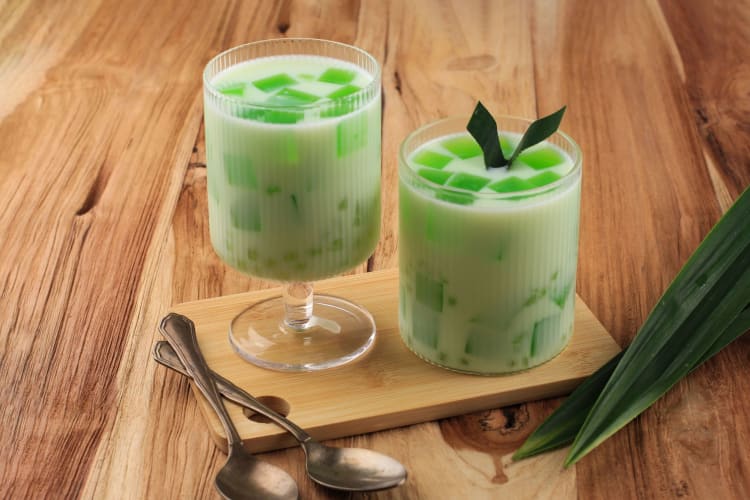
Common Filipino Spices
-
Bay Laurel Leaf: Bay leaves are commonly used in soups and stews, such as tinola or sinigang. They provide a mild, herbaceous flavor that smooths and heightens other ingredients in the pot.
-
Black Bepper: A quintessential spice in Filipino foods, black pepper adds a sharp, woody zing to many dishes.
-
Chile Pepper: Many types of chile peppers grow in the Philippines. As a whole, they are an essential spice for adding that hot, tingling sensation to tasty Filipino food recipes such as tinola or kaldereta. If you’re building a must-have list of spices for Filipino cooking, chile peppers should be at the top of that list.
-
Garlic: Almost every culture worldwide loves garlic. This strong, earthy and slightly sour ingredient is vital for creative, savory dishes like adobo and dipping sauce.
-
Ginger: Ginger has an easily recognizable spicy and sour kick. It’s a spice that will warm you up from the inside with its buzzing flavor, making it perfect for Filipino foods like tinola.
-
Lemongrass: Like ginger, lemongrass has a pungent, zingy flavor that leans more toward citrus. It is commonly used in Filipino cuisine to flavor light soups and can even be made into a tea.
-
Tamarind: Tamarind is a tangy fruit that grows in pea-like pods. It has a classic “sweet and sour” flavor and is a popular souring agent in Filipino cooking.

As you can now see, Filipino foods are an incredible combination of cultures, and yet each dish is as unique as the country itself. Whether you decide to join a cooking class, create some Filipino foods at home or travel to the Philippines for an authentic experience, we hope this article has inspired you to try something new and expand your flavor horizons!
For even more fun ways to explore your favorite foods, check out other experiences happening on Cozymeal.



FOOD FOR THOUGHT?
Join the conversation.